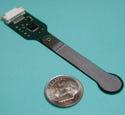May 3, 2006
Originally Published MPMN May 2006
HOTLINE
Tactile Sensors Output in Digital Format
|
Tactile sensors provide direct digital outputs at 3.3 or 5 V. |
Pressure Profile Systems Inc. (Los Angeles; www. pressureprofile.com) has announced the entry of its tactile sensors into the OEM market. The DigiTacts sensors are the first tactile sensors equipped with direct digital output capabilities, according to the company.
Whereas conventional tactile sensors produce raw analog voltage levels, the DigiTacts sensors provide digital outputs at 3.3 or 5 V. The products take pressure readings from 0 to 20 psi in 0.1-psi increments. Furthermore, the single-point pressure sensors are based on capacitance rather than resistance. Serving several functions, the units also perform signal conditioning and calibration adjustment.
The company anticipates that the digital output capabilities of the devices will benefit product design engineers because they can be easily embedded into other products. The sensors also boast stability during real-world applications, according to Jae Son, PhD, president of Pressure Profile Systems.
“Both the thinness and the performance of these sensors allow them to be easily integrated,” he says. “Many of our competitors have thinner sensors, but they get damaged after use. So, they’re okay for R&D or low-performance applications, but if you want to embed these products into another one, they have to be stable and able to work for many years.”
One such embedded application coming down the pipeline is the integration of DigiTacts sensors into surgical beds in order to monitor pressure. Many times when patients are anesthetized during surgery, they are unable to move. As a result, they can develop sores or ulcers on their skin. DigiTacts sensors could reduce this problem by monitoring the pressure exerted on immobile body parts.
“The issue was that a surgical bed company wanted to embed tactile sensors in beds, but would have to miniaturize electronics and do a lot more development,” Son explains. “Now it’s all done. The chip actually has a microcontroller so you can have many sensors. It gives you an interface that can connect directly to a computer and it can even be directly programmed to control other components.”
Robotics, machine monitoring of automated systems, and touch screens that respond to varying pressures are also among the potential early applications for the product.
Long-term plans for the sensors include a more complex version that may provide tactile sensory feedback in prosthetic devices, as well as one that would measure foot pressure for diabetics. Some diabetics lose sensitivity in their feet, a complication that can result in sores that may not heal and could require eventual amputation. Son suggests that down the road, a tactile sensor configured with a microcontroller could monitor pressure on the bottom of a patient’s foot. Theoretically, the device could stimulate people to move if they have been standing in one position for an extended period of time.
The sensors are available in 10-mm-diam circle-pad, 10 × 10-mm square-pad, and 25 × 25-mm square-pad configurations. Each one is supplied with or without a standard connector. In addition, the company offers an evaluation kit that includes a sensor, an interface board with USB connection and LCD readout, PC software, and technical support.
Copyright ©2006 Medical Product Manufacturing News
You May Also Like



